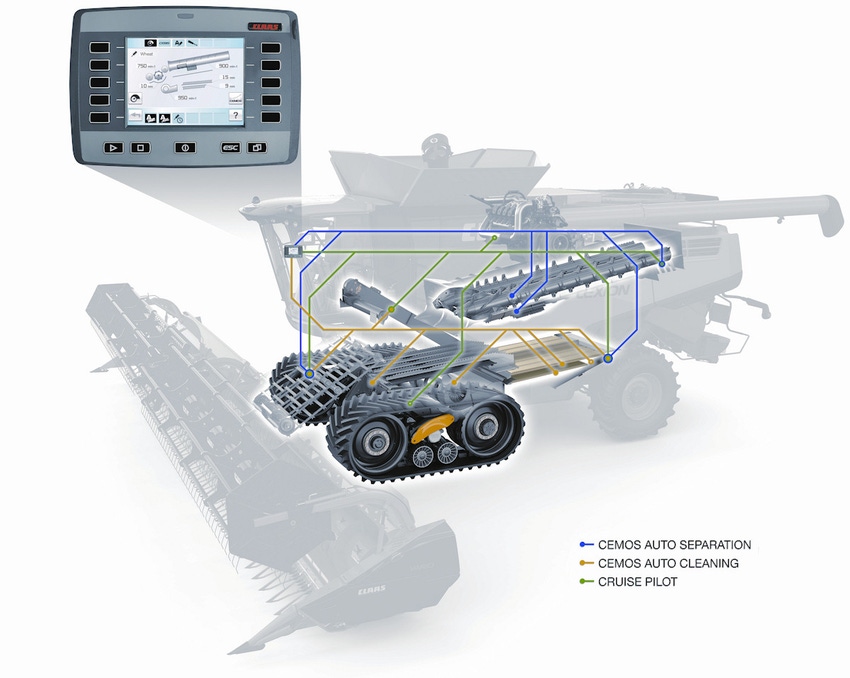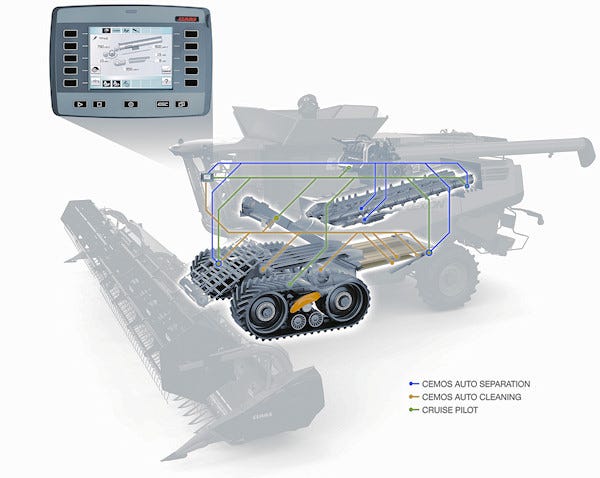November 24, 2015

Think you can outsmart a combine? Five to 10 years ago it wasn’t a competition. An experienced operator would know just when to slow down, speed up, reduce rotor speed, open up the concave and adjust the auger on the grain bin to get the most grain in the tank without shattering the kernels.
But advancements in sensor technology have given combines the intelligence and ability to adjust themselves based on harvesting conditions and to do it faster than it would take a driver to manually push a button to change the setting.
In fact, combine manufacturers will even go out on a limb and say which one is better, human or machine.
Easy enough for beginners
“With the level of onboard automation that is available today, you don’t need years of experience to be an effective combine operator. The technology offered on the new Lexion combines can make a novice or part-time operator very efficient and an experienced operator even better,” says Jeff Gray, combine product coordinator with Claas of America.
All of the commercial-scale combines you buy today have some level of “anticipatory working behavior.” The basics of how the technology works is that sensors monitor combine parameters and actuators adjust the settings. This is done in real time and without operator intervention.
In larger operations where there are multiple combines operating at the same time, the technology allows an experienced operator to set up the harvesting parameters on all of the machines to ensure consistent, efficient performance — no matter who is in the operator’s seat.
Claas achieves optimal onboard automation by leveraging the sensors found standard on its Lexion combines and stacking two different proprietary technology packages together: Cruise Pilot (a system designed to automatically control the ground speed of the combine) and Cemos Automatic (a system designed to automatically adjust sieves and fan speeds).
Gray explains that Cruise Pilot senses crop volume in the feederhouse and adjusts the ground speed of the combine before peak system loads occur. The benefit? “Cruise Pilot keeps the equipment running at the upper limit of productivity at all times for better harvest results,” he says.
While Cruise Pilot controls the ground speed, Claas’ newest technology, called the Claas Electronic Machine Optimization System Automatic, kicks in to optimize the separation and cleaning systems. “Cemos Automatic is a good example of how far automated machine control has come, as it takes more than a dozen settings for three different functions,” Gray says.
Here’s how it works

Mating sensors with software the Claas Lexion combine can use Cruise Pilot and Cemos Automatic to manage harvest on the go. The quick-response adjustments the system makes can enhance harvest quality, for any operator.
Using sensors on the combine, Cruise Pilot and Cemos Automatic technologies monitor three different functions of the combine: groundspeed or “throughput,” separating, and cleaning. It then makes immediate adjustments to the coordinating machine settings as harvesting conditions change. The operator can select the end result for each function, as illustrated.
Cruise Pilot: Cruise Pilot Automatic Ground Speed Control automatically controls the harvesting speed for best results based on engine load. Depending on the travel mode, the system monitors multiple parameters simultaneously for control: ground speed, crop volume in the feederhouse, engine load and grain losses. Three travel modes are available based on engine load: constant speed, constant throughput and constant throughput with losses.
Cemos Automatic: Cemos Automatic controls a combination of cleaning and separating systems automatically. Crop separation is optimized through automatic and autonomous adjustments of the rotor speed and rotor cover position.
Crop cleaning is optimized by continual modulation of the fan speed and the opening and closing of the upper and lower sieves.
The operator can select from one of four desired outcomes: maximum throughput (for tight harvesting windows); minimum fuel consumption (for efficiency); high threshing quality (for the best grain results); and balanced (combines the other three strategies).
For more information, visit claasofamerica.com.
About the Author(s)
You May Also Like




